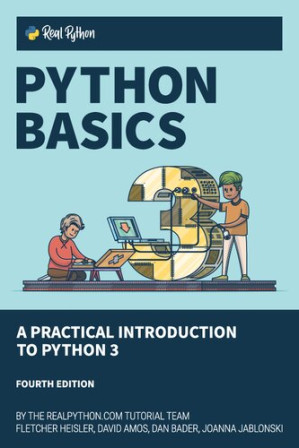Insights from Python Basics
Python Basics: A Practical introduction to Python 3
When my son expressed interest in coding, it reignited my passion for introducing Python to others. This book, Python Basics: A Practical Introduction to Python 3, is now part of the "Code Club" learning list—a collection of resources aimed at helping children at the club (and my son) discover the joy of Python.
Written by the Real Python team, this book serves as an excellent entry point for anyone new to programming. It breaks down Python’s fundamentals into digestible lessons, providing real-world examples and coding exercises. Whether you're a complete beginner or brushing up on basics, this book offers the tools to transform curiosity into skill. Readers can expect to learn the essentials of Python programming and gain confidence in solving practical problems.

Summary
The book is structured as a cohesive journey through Python’s foundational concepts, spanning 19 chapters. Below is an overview of each chapter:
Chapter 1: Introduction
The authors set the stage for Python’s versatility and popularity, explaining why it’s an excellent language for beginners and professionals alike. The chapter encourages readers to embrace coding as a skill that empowers them to automate tasks and solve problems.
Chapter 2: Setting Up Python
A practical guide to installing Python on different operating systems, ensuring readers have the right setup to follow along.
Chapter 3: Your First Python Program
Readers write their first Python program and learn about variables, comments, and running scripts. This chapter also introduces the IDLE editor.
Chapter 4: Strings and String Methods
A deep dive into string: how to manipulate, format, and interact with user input using Python’s rich set of string methods.
Chapter 5: Numbers and Math
Introduces numbers, arithmetic operations, and Python’s built-in math functions. It even ventures into complex numbers and their applications.
Chapter 6: Functions and Loops
Readers learn how to define functions, use loops effectively, and understand the concept of scope in Python.
Chapter 7: Finding and Fixing Code Bugs
This chapter introduces debugging techniques, encouraging readers to embrace mistakes as part of the learning process.
Chapter 8: Conditional Logic and Control Flow
Explains how to use conditional statements and control flow to make Python programs more dynamic and responsive.
Chapter 9: Tuples, Lists, and Dictionaries
Covers Python’s versatile data structures and how to choose the right one for specific tasks.
Chapter 10: Object-Oriented Programming (OOP)
Introduces classes, objects, and inheritance, laying the foundation for building more complex programs.
Chapter 11: Modules and Packages
Readers learn to leverage Python’s modularity by working with external modules and creating packages.
Chapter 12: File Input and Output
Explores how to handle files, read/write operations, and even work with CSV data.
Chapter 13: Installing Packages with Pip
Guides readers through using Python’s package manager, pip, to install and manage third-party libraries.
Chapter 14: Creating and Modifying PDF Files
Explains how to work with PDF files, including extracting, merging, and creating PDFs from scratch.
Chapter 15: Working with Databases
Introduces SQLite and other database libraries, demonstrating how Python can interact with data.
Chapter 16: Interacting with the Web
Covers web scraping, parsing HTML, and interacting with websites programmatically.
Chapter 17: Scientific Computing and Graphing
Explores NumPy and matplotlib, equipping readers with tools for data analysis and visualization.
Chapter 18: Graphical User Interfaces
Readers learn to create GUI applications using libraries like EasyGUI and Tkinter.
Chapter 19: Final Thoughts and Next Steps
The final chapter offers guidance on advancing further in Python, recommending additional resources and next steps.
Key Takeaways
Key Takeaway 1: Hands-On Learning Approach
- The book emphasises practice through exercises and challenges, which help solidify learning.
- This approach mirrors what we encourage at the Code Club, making it an invaluable resource for young learners.
Key Takeaway 2: Python’s Accessibility
- Python is simple enough for beginners yet powerful enough for professionals.
- Introducing this balance to the next generation of learners is a fantastic way to spark their interest in programming.
- Quote: "Python is a full-spectrum language. It’s easy to start but powerful enough for professional applications." – p. 16
Key Takeaway 3: Broad Applicability
- From data analysis to web development, Python’s versatility makes it a valuable skill for anyone.
Personal Reflections
Adding Python Basics to the Code Club’s library feels like setting a strong foundation for young learners and beginners alike. Its clear explanations and practical focus ensure that students can see the immediate impact of their code. Personally, it reminds me why I fell in love with Python in the first place: its ability to turn ideas into reality with simplicity and elegance.
Conclusion
Whether you’re a parent introducing your child to coding, an educator seeking a resource for your students, or an individual learning Python for the first time, Python Basics is an excellent starting point. Its hands-on approach and practical focus make it a must-read. Dive in, and let the journey into Python begin!